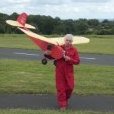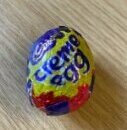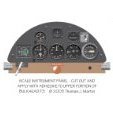-
Posts
5,972 -
Joined
-
Last visited
-
Days Won
9
David Davis last won the day on March 13 2022
David Davis had the most liked content!
Recent Profile Visitors
6,719 profile views
David Davis's Achievements
618
Reputation
-
I'm quite happy to assist a beginner to build a model aircraft.
-
I held a demonstration at the club's workshop a couple of Saturdays ago, seven of my clubmates turned up to watch. I had already covered one side of the rudder in doculam so I showed them how to cover the other side in doculam then covered one side of the rudder in De Luxe Materials Red EZE Tissue, covering the other side once I'd got back home. To date I have covered the tail surfaces in EZE Tissue, picture below. I have over-done it in one or two places when trimming the tissue resulting in balsa wood showing through so I've had to glue the odd narrow patch into position. However, the more I've used the tissue, the more skillul I've become. I am disappointed in the appearence of the tissue on the rudder but there's nothing I can do about it now that the water-based varnish has stuck the tissue to the doculam. Having covered the tailplane in the red tissue I feel that I should cover the wing in red tissue too. I shall have to order another pack of tissue anyway because there is not quite enough tissue to cover the wings. The wing panels are slightly longer than a sheet of tissue and the chord is rather more than half the width. I have some more red tissue in stock but it is a slightly different shade compared with the EZE Tissue I have used on the tailplane. Perhaps I'll use it on the underside! I have to decide whether to go for an all red scheme or the family's traditional finish of yellow fuselage and red flight surfaces. I think that my first Junior 60 finished in Orange Solartex looked quite effective so I'm leaning towards an all red scheme at the moment.
-
Did you get them?
-
If I remember correctly he had to have a foot amputated ayear or so ago. His phone number is on the website under "contact us." Ed Sherrod, if you want to contact Colin Buckle by phone please be aware that there is a time difference of at least four hours depending upon where you live within the USA.
-

Has IC engines got a future anymore ?
David Davis replied to flying daddy's topic in All Things Model Flying
I have just worked out that I own thirty-three model aeroplane engines ranging from a Mill 75 to a Laser 160 V Twin. Of these, seven are installed in models. I was seventy-seven years old on 11th March. I think I have enough engines to suit my needs for whatever time is left to me. 😉 I also have a couple of electric powered models but they don't hold the same appeal. -
I must admit to being a little confused. There is a supplier in France called Mini Planes which is stocking both the Pichler Fokker DVII and the Albatros DIII kit. https://www.miniplanes.fr/pichler-kit-fokker-d7-2100-mm-15460-p-523162.html https://www.miniplanes.fr/albatros-diii-1800-mm-15481-1-p-526237.html They look remarkably like kits offered by Value Planes and Dancing Wings to me. Has anyone bought or built one of these kits?
-

I’ve had a stroke at age44 last week!
David Davis replied to MattyB's topic in Why Not Say Hello....
Sorry to hear your news Matty but it makes me count my lucky stars. I turned seventy-seven last week and I'm in good health for a man of my age. -
I helped my Belgian friend Frans to build his Ben Buckle Electric Junior 60 which is based upon the 1946 free flight design. It has a small rudder and on the maiden flight I found it difficult to control on finals because the rudder was so ineffective unless there was considerable prop wash! It was a question of just going round again lining it up and letting it sink to the ground.
-
My usual practice is to build the fuselage first, then the wings, then the tailsurfaces, as once you get to that stage you've pretty well finished the basic construction of the model and you are motivated to go on to the covering stage. The fuselage is almost complete but this time around I have chosen to build the tail surfaces next and to use them to demonstrate to my club colleagues the technique of applying tissue over doculam. I have opted for the very large rudder as used in the Flair version of the Junior 60 and have taken a leaf out of a South American modeller's book with the diagonal ribs in the tailplane. Just a brief question for those already well-practised in using tissue over doculam. Do you apply the doculam over the sheeted area of a model, like the forward fuselage of a Junior 60, or do you stop at the open structure and apply the tissue directly to the balsa wood? Pictures of the fuselage before I fitted the nose blocks below and the tail components mostly covered in doculam. Note my dog Tiko photobombing as usual!
-
While practising for La Coupe Des Barons last week, one of the Flair wheels fell of into the plough and was lost forever. I am currently using small wheels but I would lose points in the competition if I were to use them. Rather than pay 55€ for a pair of Williams Vintage Wheels, I'm going to have a go at making a pair out of balsa and ply as Cliff Harvey has for his Sopwith Triplane. Video here: https://www.youtube.com/watch?v=M2jzMr8K-UI&t=2s. I notice that he has used 0.8mm ply discs seperated by 6mm balsa for the basic components of the wheels. Given that my Baron fitted with an OS 52 in the nose and with fuselage longerons made from basswood weighs 4lbs 4ozs or 1.9 kgs, do you think that 0.8 plywood would be strong enough for my purposes? I expect that Cliff's triplane is much lighter.
-
I had the same problem with a Junior 60 which my cousin had badly stored for several years. A trim tab cured it.
-

La Coupe Des Barons 2025
David Davis replied to David Davis's topic in Shows, Club Events and Competitions
While practising for La Coupe Des Barons last week one of the wheels fell off and disappeared into the plough. I managed to get the model down onto our 10 metre wide tarmac runway. Picture of your humble servant and the Ukrainian Baron below. Note the very small wheels. Given the cost of WW1 replica wheels I'm planning to make my own out of balsa and ply with a neoprene tyre. Any tips? -
Please let us know how you get on Adam, I'm sure that many of us would be intrested in following your progress.




